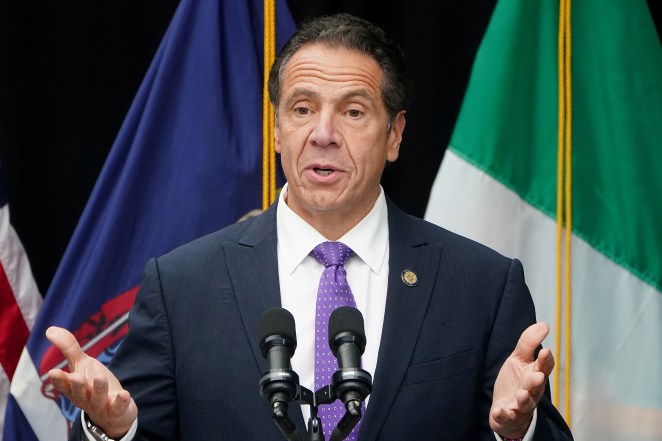Gov. Cuomo loosens COVID-19 restrictions in some NYC hot spots
Gov. Andrew Cuomo on Wednesday announced the loosening of restrictions in some New York City coronavirus hot spots as he outlined new COVID-19 positivity thresholds for the color-coded cluster zones.
Based on the new coronavirus metrics, schools and non-essential businesses in Queens hot spots will soon be able to reopen, since previous “red” (highest-risk) areas and “orange” (medium-risk) zones in the borough moved into the lesser-risk “yellow” category.
In the southern Brooklyn red zone, which includes Midwood, Borough Park, Sheepshead Bay and Gravesend, there’s still a coronavirus positivity rate of 5.5 percent, so it will remain a red zone until the infection rate goes lower, Cuomo said during an Albany press briefing.
That area will see increased coronavirus control measures.
However, Brooklyn’s orange zone has turned into a yellow zone, and the borough’s yellow zone will remain yellow.
Schools will be able to reopen Monday if they were located in areas that went from red and orange to yellow zones, while businesses in the same situation can reopen Thursday, the state said.
Cuomo’s COVID-19 color-coded cluster zone restrictions — which include the closure of schools, non-essential businesses and capacity limits in houses of worship — went into effect in areas of Brooklyn and Queens on Oct. 8 for a minimum of two weeks.
“Most restrictions in red zones [are] reducing restrictions in orange and yellow [zones],” Cuomo said.

Under Cuomo’s new thresholds for the micro-cluster restrictions, areas can exit a red zone as long as the COVID-19 infection rate is under 3 percent after 10 days or 4 percent in “less populated areas”; exit an orange zone if the infection rate is under 2 percent after 10 days or 3 percent in less populated areas; and exit a yellow zone as long as the infection rate is under 1.5 percent after 10 days or 2 percent in less populated areas.
Since the last week of September as compared to the past seven-day average, southern Brooklyn’s red zone has seen a positivity rate of 7.7 percent to 5.5 percent, while Queens’ Kew Garden Hills/Forest Hills red zone has gone from 4.1 percent to 2.5 percent, and the red zone in Far Rockaway, Queens, has gone from a 3.2 percent to a 1.8 percent infection rate, state data shows.
“That’s good news. Celebrate,” Cuomo said. “Don’t panic.”
The governor noted that the state is adding the Queens neighborhood of Ozone Park as a yellow zone due to an uptick in coronavirus cases.
Restrictions in yellow zones include 50 percent capacity limits at houses of worship, mass gatherings of 25 people maximum both indoors and outdoors, a four-person maximum per table for indoor and outdoor dining, and mandatory COVID-19 weekly testing of students and teachers at schools.
Red zones outside New York City in Rockland and Orange counties will remain red for now, according to Cuomo.
Meanwhile, Cuomo said the state is “tracking some new micro-clusters” as a result of recent COVID-19 upticks in counties along the Pennsylvania border, specifically citing Chemung County.
Cuomo explained that his micro-cluster approach is the “best” way to fight back against the spread of coronavirus.
“Detect the smallest outbreak as soon as it happens … quick action to contain it and eliminate it,” Cuomo said. “That is the best you can do in this situation.”
He added, “You see an ember land in dry grass, ring the alarm.”
Additionally, the daily statewide coronavirus positive infection rate rose to 1.6 percent Wednesday — an increase from Tuesday’s recorded rate at 1.3 percent.
The figure is inclusive of “oversampling,” or increased and targeted testing in the state’s viral cluster zones.
The Empire State’s weekly infection rate average, however, has hovered around 1.2 percent.
Cuomo explained the jump is owed to a rising viral rate tied to seasonal, cooling temperatures.
“It’s getting colder because it’s fall, the viral rate is increasing because it’s fall. The question is, what’s the relative increase?” Cuomo said. “1.2 [percent] for the week… first of all it’s the third lowest in the United States of America. Yeah it all goes up, but it’s the relative increase.”
The governor said that a “problem” New York has is the fact that the infection rates in states across the country are increasing.
There’s now 43 states on New York’s quarantine travel advisory list. Included on that list is New Jersey, Pennsylvania and Connecticut, but there’s “no practical way to quarantine” those states, Cuomo said.
The governor said he has spoken to global health experts about a plan that would utilize rapid testing as opposed to having travelers quarantine for 14 days.
“They have rapid tests now that are very quick where rather than saying everybody wait 14 days we should come up with a plan that uses testing to determine in a shorter period of time if you are infected or not. And we have to work on that, that’s all I know,” Cuomo said.